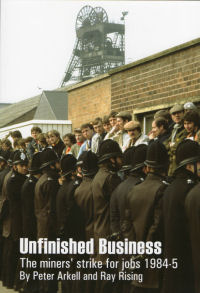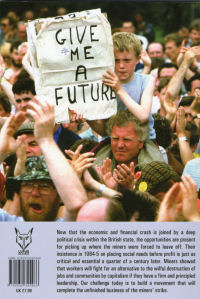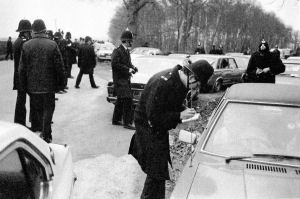Unfinished Business
The miners' strike for jobs 1984-85
Peter Arkell and Ray Rising
Published by Lupus Books
ISBN 978-0-9523454-6-6
£7.99
Review by A. Covell for MinersAdvice. August 2009.
|
Unfinished Business is a book of two halves. The first half takes on the task of providing the history behind the wonderful collection of photographs which make up the whole of the second half. In the introduction to the book the authors tell us, Unfinished Business is not written as a reminiscence on the 25th anniversary of the start of the strike, or to marvel at the courage of the miners, although no one who lived through the struggle could dispute that. Instead our book is intended to draw out the essence of the miners' strike for jobs and its enduring significance for a new period of history. We are also publishing a series of photographs, some for the very first time, taken by us and others that show the extraordinary character of the strike.� |

Front cover |
Peter Arkell and Ray Rising were News Line photographers during the strike, and as such were in the enviable position of being able to record through their photographs the events which took place on the streets of mining communities across Britain . For the first time since the strike their photographs and their memories of when Britain became a police state are together under a single cover.
For mining historians and those who took part in the strike of 1984�85 there isn't a great deal to learn from the first chapter. |

Backcover |
|
Chapter 1: Provocation and confrontation provides the reader with a good background of the political events leading up to the strike. This chapter covers the miners' victories in the early �70s and the coming of Thatcher's government in '79. We are told of the humiliation suffered by Heath's Tory government and the �Winter of discontent' which followed the subsequent Labour government's struggle against an economic crisis. Thatcher's plans for a showdown with the unions are discussed and the adoption of the Ridley plan, a proposal outlined in 1974 by Tory MP Nicholas Ridley, in which it was proposed how the next Conservative government could fight and defeat a major strike.
The second part of Chapter 1, �The provocation � the miners launch their strike covers the start of the strike and the drafting of thousands of police officers into the miners' communities and how this force was used to restrict miners' movements and prevent pickets getting into Nottingham.
|
The question of the �ballot', a cry that was often heard from the throats of Notts miners who had no intention of joining the strike is addressed in this section. Using transcripts of a report made to The Guardian newspaper on 7th March 2009 by Arthur Scargill, we are told how the NUM followed their own rules with regards to the strike ballot and that the call for a ballot was simply a Tory ruse to halt the strike and bring about a cooling off period.
The ineffectuality of the TUC throughout the strike and the decision of the NACODS union not to join their fellow mineworkers in strike action are discussed as Chapter 1 comes to a conclusion with the decision made by the NUM on March 3rd 2005 to return to work.
|

Police stop pickets from leaving Yorkshire
|
|
Civil war in Hatfield
The next chapter is devoted to Hatfield Colliery and the events which occurred there in the summer of 1984. On a hot sunny day in August a lone strike breaker rode the bus across the picket line at Hatfield Main, a pit which had remained solid for the first five months of the strike. It was totally unexpected, but judging by the police response it had been well planned. As the people of Stainforth and Hatfield waited for the scab to return from the pit so they could voice their anger they staged a peaceful sit-in, blocking the single entrance to the colliery. When the time came for the scab to be bussed away from the mine the police acted to clear the way for him. In a rash act of violence they charged, some on horseback and some in body armour and wielding clubs, into the unprotected crowd to make a bloody path of escape for the scab bus. Ray Rising and his collegues were there to see those events and witnessed several crucial moments which they captured on camera.
Ray Rising sent me a piece about his experiences in Stainforth and at Hatfield Colliery which I have uploaded, along with some his photographs taken that day and which he has graciously allowed us to use, to the MinersAdvice site: Your View: Re-visiting the miners' strike 1984-85
The final chapter of the first half of Unfinished Business is The way forward .
A World to Win is a movement which the authors tell us is struggling for the implementation of a People's Charter for Democracy. In this chapter they tell us the aims of A World to Win and how they aim to learn and build on the events of 1984-85 by preventing capitalism from turning other industries and communities into wastelands, and why, for them, the great miners' strike remains unfinished business.
The fight against pit closures � the year in photographs .
Page 51 to the penultimate page of this 96 page book is dedicated entirely to photographs, and it is this part of the book which makes it such a valuable asset for mining historians, social historians, or anyone who wants to see for themselves the events of the year long miners strike as witnessed by those who were actually there.
|
 |
You must have heard the phrase �a picture paints a thousand words�, which is often accredited to American advertising executive Frederick R. Barnard in 1921. In the case of Unfinished Business the photographs in the latter half of this book say many times more than has been said in the first few chapters. Starting with an amazing image of the upturned faces of miners and police officers gathered outside the NUM headquarters in Sheffield in April 1984, a collection of over sixty photographs depicts the events of the following year. Added to the photographs used to illustrate the Hatfield article and those used in Chapter 1, this takes the total number of photographs reproduced in this book to over eighty.
There are photographs of picket lines, police lines, women's support groups and communities struggling to survive. There are photographs of miners being handcuffed and beaten and of defiant communities marching behind their banners. |
|
Some of these images have surpassed being records of the miners' strike and have themselves become unforgettable icons depicting the working class standing bravely before the might of their oppressors. Among the well known images are some that are in print for the first time but which will also stand to illustrate the tyranny the miners and their families were subjected to for a full year
This is a book of images showing events which we will never see the likes of again in our lifetimes. They show proud mining communities standing unbowed, they show the unity and strength of those who were part of a nationalised industry, and they show the lengths a capitalist government was willing to go to destroy their communities and their industries.
In my opinion this book is an excellent pictorial record of one of the most controversial years of mining history. |
Links
Revisiting the miners' strike - Stainforth Hatfield August 1984
Ray Rising sent us this article about a day in August 1984 when he witnessed some of the darkest events to be seen at Hatfield during the strike. http://www.aworldtowin.net/
for a future without global capitalism ...
|




